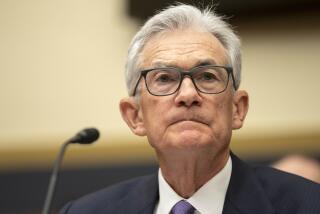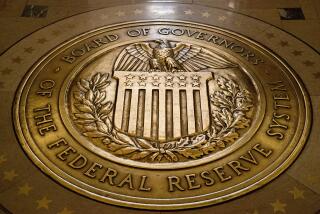Fed announces new effort to soothe money markets

The Federal Reserve stepped up its efforts to reduce volatility in short-term lending markets, announcing Friday that it would inject up to $90 billion in two-week loans into the financial system starting next week.
The new facility was revealed after the Federal Reserve Bank of New York offered overnight loans for a fourth consecutive day, helping to steady conditions in the U.S. repo market, where banks and investors make short-term loans in exchange for Treasurys and other high-quality collateral.
The central bank said that it would expand its interventions beyond overnight loans after the lending rate for two-week funds rose sharply — an indication that investors were anticipating a fresh financing squeeze at the end of the quarter, when companies and traders settle their accounts. The new two-week loans will be offered in three operations: on Tuesday, Thursday and Friday.
“The fact they are willing to telegraph this over quarter-end reduces the potential for funding market volatility like we have seen over this week,” said Benjamin Jeffery, an interest rate strategist at BMO Capital Markets. “It should hopefully offer some stability to repo markets over the next 10 days.”
The year’s third quarter concludes at the end of this month.
The U.S. central bank’s New York branch offered $75 billion of overnight funds Friday, after an unusual jump in borrowing costs earlier in the week caused it to intervene in the short-term money markets for the first time in a decade.
The overnight Treasury repo rate had surged as high as 10% on Tuesday. By Friday, it had receded to 1.95%.
The effective federal funds rate, which is the Fed’s main policy tool, also fell back to within the central bank’s intended range of 1.75% to 2%. Earlier in the week, it shot above its target in an unusual breach, which some analysts said suggested that the central bank had at least temporarily lost control of the market.
The worrisome development Friday was a rise in the two-week repo rate to 2.7%, up from 2.35% in previous days, suggesting that lending availability over this period has begun to tighten.
U.S. banks and investors have warned that a flare-up may occur again during quarter and year-ends, when there is typically a high demand for cash.
“We think investors should be prepared for deteriorating liquidity in the funding markets into year-end and the impact of this on the financial markets as a whole, with potential costs for levered strategies and risk assets in particular,” said Jerome Schneider, head of short-term portfolio management at Pimco, the world’s biggest bond manager.
Analysts blamed a confluence of factors — some structural and others temporary — for the crunch in a part of the money markets where Treasurys are exchanged for cash in transactions that reverse overnight.
“None of these pressures was extraordinary or unforeseen, but together they had an extraordinary impact,” Schneider said.
He echoed the analysis of others, saying $35 billion was yanked from money market funds before U.S. corporate tax payments were due this week. At the same time, dealers needed to finance an additional $20 billion in Treasurys, acutely increasing the demand for cash sourced through repo transactions.
Generally, banks would have stepped into the repo market. But falling excess reserves meant that they were less willing to use their cash in repo transactions.
Friday’s overnight repo auction by the New York Fed saw a lower level of demand from borrowers than the previous two days. Bids came in at $75.6 billion, down from $84 billion Thursday and $80 billion Wednesday.
On Tuesday, the first day on which the $75 billion overnight repo facility was offered, the New York Fed saw $53 billion of bids.
© The Financial Times Limited 2019. All Rights Reserved. FT and Financial Times are trademarks of the Financial Times Ltd. Not to be redistributed, copied or modified in any way.






